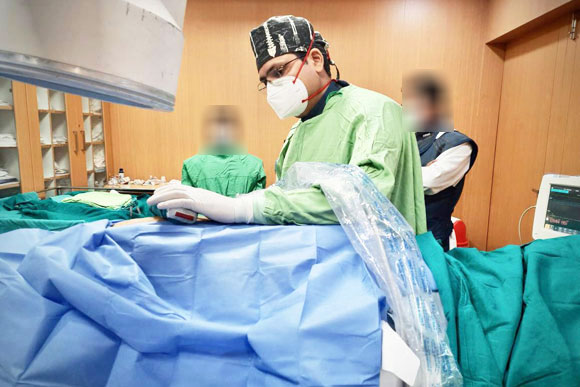What is cryoablation?
Imagine being able to freeze nerves to minus 80 degrees Celsius to manage pain. This isn’t science fiction; it’s a reality with cryoablation. The term “cryoablation” breaks down to “cryo” meaning cold and “ablation” meaning destruction. This innovative, minimally invasive technique uses extreme cold to temporarily disable nerve function and reduce pain. Cryoablation interrupts pain signals transmitted to the brain, providing an alternative to traditional nerve destruction methods like alcohol neurolysis or surgery, in certain situations.
Which type of pain conditions can be treated using this technology?
Cryoablation is effective for a variety of common pain conditions, including:
Acute and Post-Surgery Pain: Used for pain associated with surgeries such as hernia repair, rib fractures, thoracotomy (chest surgery), mastectomy (breast surgery), shoulder surgery, and knee replacement surgery.
Musculoskeletal pain such as shoulder or knee pain secondary to arthritis.
- Shoulder pain: arthritis, rotator cuff repair, adhesive capsulitis, bursitis.
- Knee pain: osteoarthritis, persistent post-surgical pain.
- Hip pain: osteoarthritis, avascular necrosis, trochanteric bursitis.
- Chest pain: Post-rib fracture and persisting costochondritis pain.
Chronic longstanding painconditions such as
- Chest wall pain:Including post thoracotomy, post herpetic (after herpes zoster infection) pain, and pain originating from chest nerves (intercostal Neuralgia).
- Chronic groin and pelvic pain:Including genital pain.
- Headache disorders:with favourable response to nerve blocks such as the Occipital, supraorbital or supratrochlear nerves.
- Phantom Limb Pain:common after amputation.
Nerve (Neuropathic) pain such as headaches from occipital Neuralgia or thigh pain form meralgia paresthetica, neuroma pain after amputation. Neuromas including Morton’s and Stump neuromas.
Spinal pain: such as from the arthritis of spinal joints (facet joint pain) in neck, middle of back, lower back, and pelvis joints (Sacroiliac Joints)
Chronic post-surgical pain (CPSP)- Post-surgical pain secondary to nerve injuries and entrapments in scar tissue or mesh can be treated with cryoablation. It is frequently used for treating persisting pain after chest wall, hernia, and amputation surgery.
Cancer pain: Localized to a nerve or region, particularly in cases of tumor infiltration of nerves. Has been used for pain related to abdominal, pelvic, and thoracic neoplasms.
How does it Work?
As explained earlier cryoablation involves applying extreme cold to targeted nerves, causing reversible nerve injury that stops the nerve from transmitting pain signals. The temperatures range from −20°C to −100°C, causing a temporary disruption of the nerve with the potential for regeneration. This interruption prevents pain signals from reaching the brain, offering immediate and prolonged relief.
How is cryoablation performed?
The procedure is simple, minimally invasive, and doesn’t require cuts, incisions, or suturing. Performed as a day-care procedure, it typically doesn’t require general anesthesia. Using a cryoprobe and a cryoablation machine, gases like nitrous oxide or carbon dioxide are delivered through the probe, creating extremely low temperatures at the probe tip. The probe is placed near the target nerve using ultrasound, X-ray, or CT guidance, and the freezing mode is activated. An ice ball forms at the probe tip, freezing the nearby nerves and reducing their ability to transmit pain. After the procedure, the cryoprobe is removed, and the site is covered with a small bandage.
What are the advantages of cryoablation?
Cryoablation offers several benefits over other pain relief methods:
- Immediate and prolonged relief: Unlike other treatments like steroid injections and radiofrequency, cryoablation provides rapid relief, with nerve recovery taking six to twelve months, and sometimes even longer.
- Minimally Invasive:No cuts or incisions are needed, and the procedure is performed using image guidance as an outpatient or day-care procedure.
- Safety: Minimal to no risk of worsening pain, as there’s no risk of neuroma formation. The use of ultrasound and nerve stimulators ensures correct nerve identification and precise treatment.The formation of ice ball can be monitored real-time.
- Repeatable:Treatments can be repeated as necessary without increased risks.
- Reduced Painkiller Requirements:Less reliance on pain medications reduces their side effects.
- Reduced Patient and Healthcare Burden:Early discharge and minimal monitoring requirements lower healthcare costs and improve patient convenience.
Cryoablation represents a significant advancement in pain management, providing a safe, effective, and minimally invasive alternative to traditional treatments.
This Treatment Option Is Available In India At The International Pain Center. Feel Free To Contact Us
On +91-9993336525
Further Reading
For those who are interested in knowing more, the article below can be helpful.
- Biel E, Aroke EN, Maye J, Zhang SJ. The applications of cryoneurolysis for acute and chronic pain management. Pain Pract. 2023 Feb;23(2):204-215. doi: 10.1111/papr.13182. Epub 2022 Dec 4. PMID: 36370129; PMCID: PMC10107282.
- Trescot AM. Cryoanalgesia in interventional pain management. Pain Physician. 2003 Jul;6(3):345-60. PMID: 16880882.
- Filippiadis D, Efthymiou E, Tsochatzis A, Kelekis A, Prologo JD. Percutaneous cryoanalgesia for pain palliation: Current status and future trends. DiagnInterv Imaging. 2021 May;102(5):273-278. doi: 10.1016/j.diii.2020.11.007. Epub 2020 Dec 3. PMID: 33281081. .
- Erinjeri JP, Clark TW. Cryoablation: mechanism of action and devices. J VascIntervRadiol. 2010 Aug;21(8 Suppl):S187-91. doi: 10.1016/j.jvir.2009.12.403. PMID: 20656228; PMCID: PMC6661161.
- Ilfeld BM, Finneran JJ. Cryoneurolysis and Percutaneous Peripheral Nerve Stimulation to Treat Acute Pain. Anesthesiology. 2020 Nov 1;133(5):1127-1149. doi: 10.1097/ALN.0000000000003532. PMID: 32898231.



 :
:









